 I am passionate about olives and olive oil. I use lots of it and always stop at olive oil stores in every city we visit. After a 3-day Olive Oil Seminar and Tasting with famous super tasters from around the world, and visiting the award winners, we have educated ourselves about what olive oil to buy and from where. Each year the olive oil harvest profile in every country changes, and we are dedicated to having only the freshest and latest harvest for our customers. We have learned why some olive oil producers win awards and others do not. We eliminate the mystique of which olive oil to buy and how to use each one, and we share this with everyone that purchases from us.
I am passionate about olives and olive oil. I use lots of it and always stop at olive oil stores in every city we visit. After a 3-day Olive Oil Seminar and Tasting with famous super tasters from around the world, and visiting the award winners, we have educated ourselves about what olive oil to buy and from where. Each year the olive oil harvest profile in every country changes, and we are dedicated to having only the freshest and latest harvest for our customers. We have learned why some olive oil producers win awards and others do not. We eliminate the mystique of which olive oil to buy and how to use each one, and we share this with everyone that purchases from us.

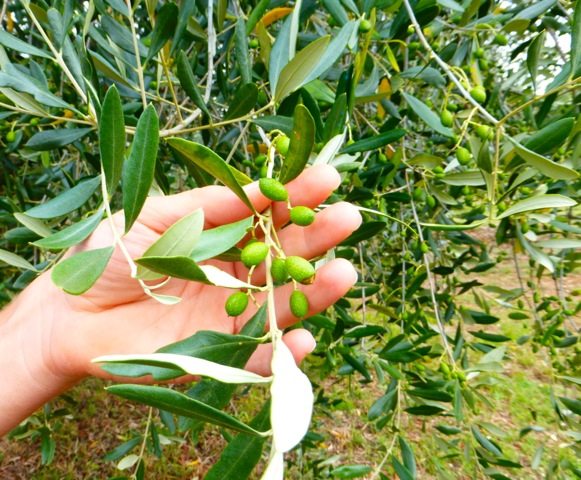
What should I know about olive oil?
Wine gets better with age. Olive oil is the opposite. We want only the freshest and freshly picked and pressed olives for oil. And olive oil is meant to be consumeed within 18 months of harvest. That means you’ll want to use it frequently.
Our mission is to introduce the best quality olive oils and vinegars to our customers in a fun environment, with a variety of tastes at a fair value. That can be achieved through education about the different types of oil and vinegars for healthy eating. Our customers have a zest for life and appreciate great natural foods.
Olive oil is the pure juice of pressed olives. An olive oil is defined by the olive variety, the maturity of the olives when harvested, how the olives are handled during harvest and how quickly they are crushed after picking. The taste of an olive oil depends upon where the olives are grown, and the time of the harvest. Northern hemisphere olives are harvested in the fall, southern hemisphere harvested 6 months later. Climate, soil, and weather are all factors in the harvest, which is why the best olive oils can come from different locations every year.
We focus on artisans and producers in the US and around the world and will always have the freshest extra virgin olive oils in the marketplace to offer our customers. As soon as it is available we offer it in our store. Usually California olive oil is available first, and then the product comes from Europe a few weeks later. We only carry pure Extra Virgin Olive Oil (EVOO) in our store.
Olives that are harvested early, before they are fully ripened, yield less oil, have a deeper green color and a higher level of bitterness and pungency and contain a higher level of chlorophyll therefore a higher poly-phenol count. This is called Early Harvest. Poly-phenols are the compound that provide many of the health benefits (antioxidants).
Many olive oils are certified organic, however many small producers practice organic methods of farming but don’t pay for the expensive official certification. You can trust that we know our producers and ask for all the chemical analysis of the oil.
The color of the olive oil depends upon the pigments in the fruit. Green olives give a green oil because of the high chlorophyll content. Ripe olives give a yellow oil because of the carotenoid pigments. The color of the oil is influenced by the combination and proportions of pigments.
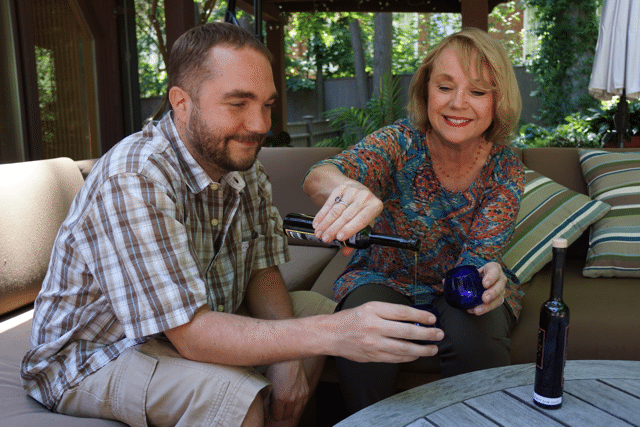
What should olive oil taste like?
Olive oil has many different tastes. Some can describe the taste of sage, wild artichokes, tomato leaves, almonds, and bananas. People we know have described olive oil as anything from mild and fruity4 to grassy and herbaceous to bold and buttery with a pleasant peppery finish. Regardless of how it is described, the flavor of olive oil should linger in your mouth after the initial taste.
No matter how olive oil tastes to you, the Greeks had it right when they described olive oil as “Liquid Gold.”
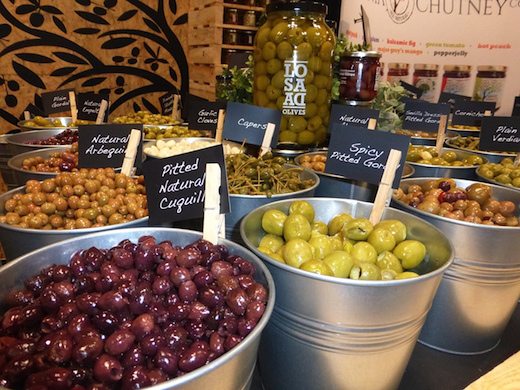
Do different olives taste differently?
We have a tasting bar for olive oil. We carry only the highest quality extra virgin olive oil and are always ready for our customers to taste before purchasing. We want everyone to love the taste they selected for themselves or for hostess gifts. From fruity olive oil for salad dressings to or a bold and peppery option for a finishing oil on soups or bitter greens, we have something for every taste and application.
There are hundreds of varietals of olives. Each possess their own unique characteristics. For example, the Arbequina variety from Spain produces a delicate oil while the Frantoio variety, found in Tuscany offers a bold, rich taste of artichokes. Both varietals are grown in California and because of the age of the trees, soil and climate conditions the olive oil can have different characteristics. Like a vintner creates a recipe for fine wines, so does a producer of olive oils. There are single varietal oils as well as mixed blends. The bottom line is that no two olive oils are the same.

How do I know if an olive oil is a quality oil?
The best answer is to trust where you buy your olive oil. Specialty stores have a reputation of offering only the best and freshest olive oil. The California Olive Oil Council has strict labeling requirements. Look also for the official seals from Italy and Spain. At Olive Connection we carry award-winning olive oils every season. We trust the super tasters and contests in every country and region. The New York International Olive Oil Awards every spring are a key to the best olive oils in the world.
Are there particular olive oils that match specific foods?
The short answer is yes, but the reality is matching oils and foods comes down to personal taste. Light and delicate dishes such as fish and salads and soups may be best with a milder fruity olive oil. More robust, full flavored dishes made with red meat and tomato-based sauces, as well as hearty stews and steamed vegetables, may be better with medium to stronger intensity oils.
Arbequina and Koroneiki are the go to starter olive oils. They both pair well with salads and are great for dipping. Flavored oils are always available. Some oils are called fused which means the herbs (i.e. basil) or fruits (i.e. lemon) are crushed alongside the olives to produce their blended recipe. Infused means that the herbs or fruit are added after the olives are crushed. We carry both fused and infused olive oils.
What is the basic 101 course on the types of olives?
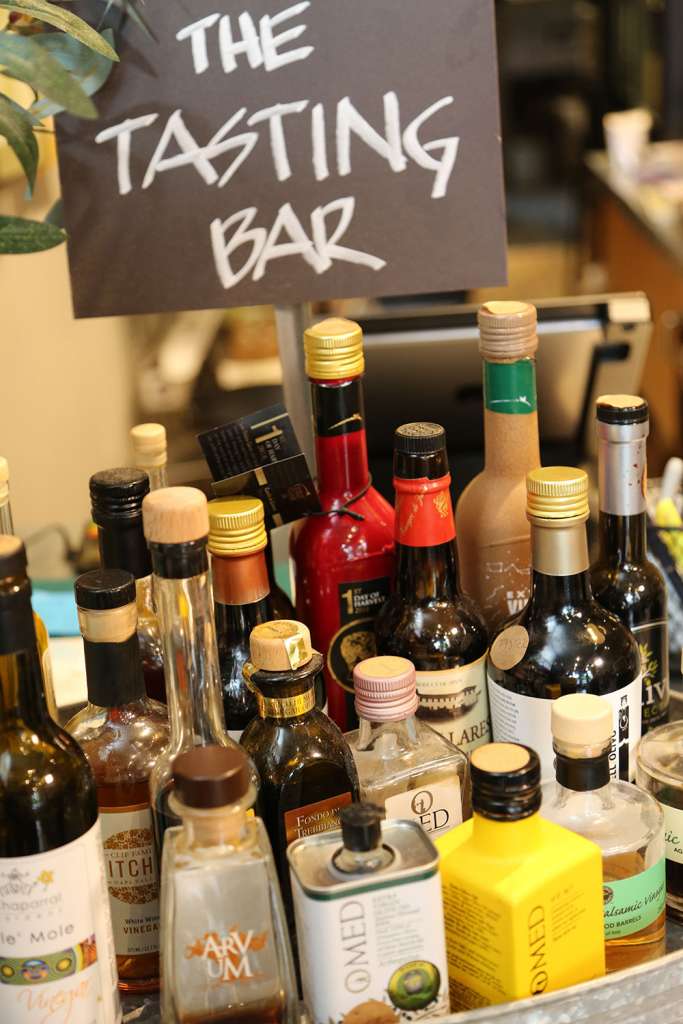 Koroneiki is the most popular olive in Greece. Taste differences depend on the geographical location of the trees, soil and climate. Some olive oil we carry at Olive Connection is from the seashore, and others from the mountains in the interior of the country. California also produces Koroneiki olives.
Koroneiki is the most popular olive in Greece. Taste differences depend on the geographical location of the trees, soil and climate. Some olive oil we carry at Olive Connection is from the seashore, and others from the mountains in the interior of the country. California also produces Koroneiki olives.
The oil is fresh, green, and aromatic, with an intensity from delicate to medium. The aroma is dried herbs, along with apple, tomato, and dried mint. Slight chicory bitterness on the palate, with radish flavor and a nutty finish. Early harvest is similar with more radicchio bitterness and mild radish, peppery, nutty finish.
Arbequina is the most versatile and grown in many areas of the world. The oil from this olive is mild and buttery, with a light peppery finish. It is also described as light and fruity with a complex aroma of ripe fruit, banana, and basil. It has a smooth taste with a balance of mild bitterness and pungency. Spain and California produce the Arbequina olives.
Hojiblanca is usually from Spain, a medium intense, fruity oil with elegant notes of ripe tomato, tropical fruit, and almond. Flavor is robust and pungent with a pleasant aftertaste.
Coratina are large oval olives. The fruit ripens evenly and late in the season. Coratina olives produce very high-quality oil with high levels of poly-phenols making it very stable and intensely pungent. These olives create an oil that has a robust intensity, with characteristics of both almonds and artichokes and a spicy finish.
Picual olives have a distinctive shape, with a marked point at the end of the fruit. Picual olives ripen from mid-November through late December. Picual is one of the most stable olive oils in the world due to a very high poly-phenol count and also stands up well to high heat during cooking. The flavor is very powerful and flavorful causing a bite in the back of the throat. Picual is fruity with a sweetish taste and low pungency without being bitter. Medium intensity, with a taste of fresh tomatoes, figs and banana skin. Our Picual olive oil is from Spain and a producer of organic and biodynamic oils from a generational family that wins many awards.
Nocellara are large plump green olives mostly from Sicily that make good table olives and good oil. They are known as the “starter” olive – if you’re acquiring a taste for olives, start here. When being used for oil, the olives are harvested early to get a light, fruity oil. For table olives, they are harvested when they reach a brownish green color. (Castelvetrano is another name for this eating olive.)
Frantoio olives are chock full of pepper and extremely pungent. This oil is robust green and has high anti-oxidant content without bitterness. It rewards a diner with lingering, healthy burn. Italy and California grow this olive and it is also used in blends.
Italy is known for their blends of olives and planting trees based on the blends they want to use for their signature oils. There are hundreds more varietals to choose from in the world. Enjoy the exciting discovery of tastes and educating your palate to the wonder of olives.
Is there a proper way to taste olive oil?
To truly appreciate the taste of olive oil you should pour, smell, sip, and gasp. Once you pour the oil, sniff it with both nostrils, take a sip and let it slide down your tongue. Then take a short gasp of air through your mouth. That gasp will bring out the subtleties of the oil. Wait a few seconds and let the oil linger before swallowing. Unlike wine, never slosh the oil around in your mouth.
Has your nose perceived any fruity sensations?
Have you detected any apple, almond, tomato or other plant notes?
Has your palate perceived any bitter and spicy notes?
Have you perceived any vegetal notes…have you discovered the extraordinary aromas and flavors? Do you like it?
How should I care for a bottle of olive oil?
Treat your bottle of olive oil with loving care and it will return the favor. Dark bottles or tins are the best for storage. Clear bottles or cruets need to be stored in a dark cupboard. Light heat, and air are the enemies of olive oil. When exposed to oxidation the oil may become rancid.
Consume your oil within 18 months of harvest…Use it frequently. Check the date of the harvest on the bottle or it will be available in the store. Many bottles have a ‘best before’ date printed on the label. In Italy they say “a good wine lasts one dinner, a good oil lasts many meals.”
Will olive oil improve my health?
Research shows that the Mediterranean diet, which includes 4-5 tablespoons of olive oil each day, along with a handful of nuts, counteracts the effects of aging on the brain. The Mediterranean diet also improves cardiovascular health, emphasizing vegetables, fruits, unrefined grains, beans, fish, wine (yah) and minimal consumption of meat and full-fat dairy products.
Olive oil has a multitude of health benefits:
-Keeps your heart young and healthy
-Reduces inflammation
-Rich in antioxidants
-Decreases the risk of cancer and diabetes
-Helps prevent memory loss
-Effective in lowing blood pressure
How about a bit of cooking tips?
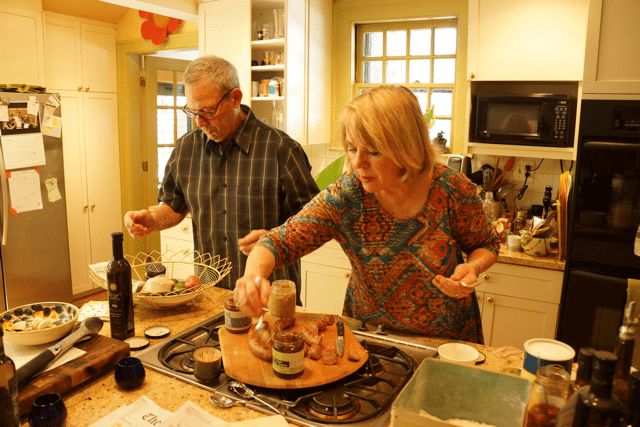
For frying, olive oil has a higher temperature than other oils. The high temperature enables the formation of the crust which acts as a barrier preventing the oil from reaching the food being cooked. The result is a dry fry that is not greasy.
Butter to olive oil conversions:
1 teaspoon butter = ¾ teaspoon oil
1 tablespoon butter = 2-1/4 teaspoons oil
Adding blood orange olive oil to brownies gives them a wonderful taste. Traditional Italian cookies are only made with olive oil. Here is a recipe for Olive Oil Cake:
Orange-scented olive oil cake
Deborah Hansen | Chef-Owner-Sommelier, Taberna de Haro
Makes 1 cake, but you can easily double the recipe to make 2 which I recommend!
This moist and irresistible loaf is a pound cake made with olive oil instead of butter. Serve it wither fresh or cooked fruit, or a thin chocolate sauce. It is wonderful with tea or coffee for breakfast, with some soft cheese to accompany. On Valentine’s Day we server it with raspberries cooked briefly with a bit of sugar for sweet, red drama.
juice of 1 orange and 1 lemon, plus the zest finely grated
1 cup of Spanish extra virgin olive oil
4 eggs
1 cup of sugar
1 cup white flour
1½ tsp. baking powder
½ tsp. baking soda
1 pinch salt
Preheat oven to 350° F. Oil and flour a loaf pan.
In mixing bowl, beat the fruit juice and zest, olive oil, eggs and sugar for 5 minutes. In another bowl, stir together the flour, baking powder, baking soda, and salt.
Turn the mixer to the slowest speed, and stir in the flour mixture.
Turn the oven down to 325° and bake for 1 hour and 10 minutes.
Allow to cool for at least 10 minutes before slicing.
